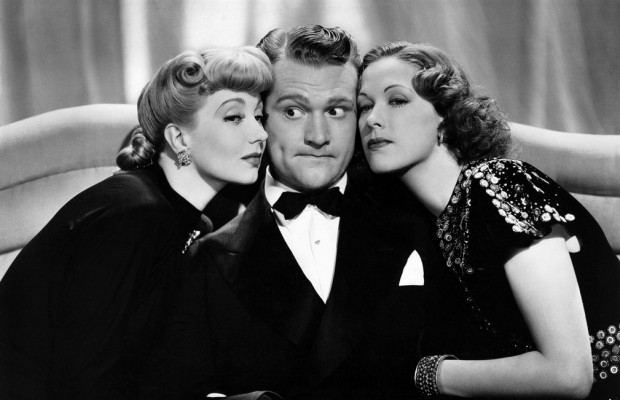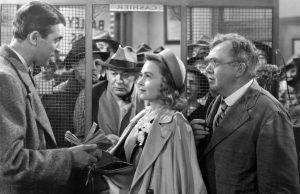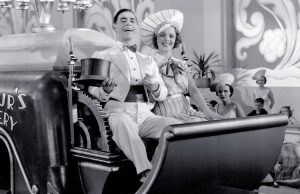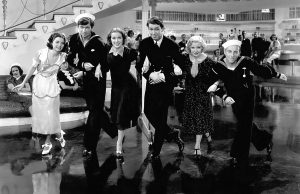Lady Be Good (1941)
By Toronto Film Society on February 11, 2014
Toronto Film Society presented Lady Be Good on Sunday, December 8, 2013 in a double bill with Hooray for Love, as part of the Season 66 Sunday Afternoon Film Buff Series, Programme 3.
Any resemblance between this film and the original 1920s Broadway hit musical Lady Be Good is almost coincidental. MGM retained only the title and two songs from the original  score by George and Ira Gershwin. This movie has a completely new story line and features numbers by several additional songwriters. Busby Berkeley was originally slated to direct, but was replaced during production by Norman Z. McLeod. However, Berkeley was kept on to direct the musical numbers; his skills are on display in the masterful “Fascinatin’ Rhythm” number at the end, making full use of MGM’s signature big swooshy curtains of the period to showcase Eleanor Powell’s long, intricately staged dance.
score by George and Ira Gershwin. This movie has a completely new story line and features numbers by several additional songwriters. Busby Berkeley was originally slated to direct, but was replaced during production by Norman Z. McLeod. However, Berkeley was kept on to direct the musical numbers; his skills are on display in the masterful “Fascinatin’ Rhythm” number at the end, making full use of MGM’s signature big swooshy curtains of the period to showcase Eleanor Powell’s long, intricately staged dance.
This film includes the lovely song “The Last Time I Saw Paris,” by Jerome Kern and Oscar Hammerstein II. When it won the Oscar for  Best Song of 1941, great controversy erupted in Hollywood because it had not been written for the film. The song was originally written in heartfelt response to the Nazi occupation of Paris in 1940. After six versions by various artists made it to the charts, MGM brought the rights to it for use in movies. Following the Oscar win, Academy rules were tightened; now nominated songs must be written specifically for the film. Despite his Oscar win, its songwriter Jerome Kern led the fight for the Academy Award rule change, saying afterward he’d voted for the Harold Arlen-Johnny Mercer song “Blues in the Night” as Best Song in protest.
Best Song of 1941, great controversy erupted in Hollywood because it had not been written for the film. The song was originally written in heartfelt response to the Nazi occupation of Paris in 1940. After six versions by various artists made it to the charts, MGM brought the rights to it for use in movies. Following the Oscar win, Academy rules were tightened; now nominated songs must be written specifically for the film. Despite his Oscar win, its songwriter Jerome Kern led the fight for the Academy Award rule change, saying afterward he’d voted for the Harold Arlen-Johnny Mercer song “Blues in the Night” as Best Song in protest.
Lady Be Good features two of MGM’s finest second-string stars, ANN SOTHERN and ROBERT YOUNG. In many ways, the two had very similar careers, both at MGM and  afterward. Both entered films in the early 1930s. Both were reliable, talented and attractive. MGM cast them as stars of “B” movies and supporting players in “A” movies. Both overcame career slumps in the 1950s by turning to television, and both became much bigger stars in that new medium. Each starred in two very successful TV shows: Sothern in Private Secretary (1953-57) and The Ann Sothern Show (1958-61), while Young starred in Father Knows Best (first on radio from 1949-54, then on television from 1954-1960) and Marcus Welby MD (1969-76). They appeared together in other films at the studio, notably Maisie (1939), a story about a brassy, self-reliant showgirl MGM had originally purchased the property with Jean Harlow in mind, but nothing had come of it. Sothern’s very likeable Maisie launched a successful series of ten films that lasted until 1947. She also starred in the popular radio spinoff The Adventures of Maisie from 1945-53.
afterward. Both entered films in the early 1930s. Both were reliable, talented and attractive. MGM cast them as stars of “B” movies and supporting players in “A” movies. Both overcame career slumps in the 1950s by turning to television, and both became much bigger stars in that new medium. Each starred in two very successful TV shows: Sothern in Private Secretary (1953-57) and The Ann Sothern Show (1958-61), while Young starred in Father Knows Best (first on radio from 1949-54, then on television from 1954-1960) and Marcus Welby MD (1969-76). They appeared together in other films at the studio, notably Maisie (1939), a story about a brassy, self-reliant showgirl MGM had originally purchased the property with Jean Harlow in mind, but nothing had come of it. Sothern’s very likeable Maisie launched a successful series of ten films that lasted until 1947. She also starred in the popular radio spinoff The Adventures of Maisie from 1945-53.
Though they shared many career similarities, Sothern and Young differed emotionally. Despite failed marriages, major health problems and the many ups and downs of a long career,  Ann Sothern remained a resilient, optimistic person. But genial, easygoing Robert Young was plagued by depression throughout his life, and survived several suicide attempts. He also struggled hard to beat alcoholism. Later in life, he spoke candidly about his personal problems, and encouraged others to seek help. The Robert Young Center for Community Mental Health, in Rock Island, Illinois, is named for him. Both Young and Sothern had long lives. He died of natural causes at his home in 1998, at 91. Ann Sothern died of heart failure in 2001, aged 92.
Ann Sothern remained a resilient, optimistic person. But genial, easygoing Robert Young was plagued by depression throughout his life, and survived several suicide attempts. He also struggled hard to beat alcoholism. Later in life, he spoke candidly about his personal problems, and encouraged others to seek help. The Robert Young Center for Community Mental Health, in Rock Island, Illinois, is named for him. Both Young and Sothern had long lives. He died of natural causes at his home in 1998, at 91. Ann Sothern died of heart failure in 2001, aged 92.
Comic singer VIRGINIA O’BRIEN–dubbed “Miss Red Hot Frozen Face” by studio publicity–is little remembered today, but she was a very popular ’40s novelty performer. Her  deadpan style first occurred y accident: on opening night in her first stage show, she suddenly suffered severe stage fright. Though she “froze” on stage, she managed to keep on singing. The audience found it hilarious, and her act was born. After 17 films, MGM dropped her in 1948. Virginia turned to TV and the stage, where she worked for another 30 years before retiring.
deadpan style first occurred y accident: on opening night in her first stage show, she suddenly suffered severe stage fright. Though she “froze” on stage, she managed to keep on singing. The audience found it hilarious, and her act was born. After 17 films, MGM dropped her in 1948. Virginia turned to TV and the stage, where she worked for another 30 years before retiring.
It may seem puzzling that though MGM’s famed female dancing star ELEANOR POWELL is top-billed here, she plays only a supporting role–and that such a big star was cast in a middle-budget musical in the first place. Studio politics and the lifespan of stardom are the reasons. Though she danced as well as ever, by 1941 Powell’s career had fallen into steep decline and she was on the way out. Her star status at MGM had lasted about five years by then–the average span for stars of the era. Unless a star  had increased their appeal by such a juncture, studios tended to lose interest and drop them. Though Eleanor was a remarkable tap dancer and a very hard worker, her dazzling, rapid-fire style had lost its initial novelty. Attempts to widen her range and partner her (notably with Fred Astaire in Broadway Melody of 1940) fell somewhat flat. In his autobiography, Astaire later recalled her rather formidable style: “She ‘put ’em down like a man’, no ricky-ticky-sissy stuff with Ellie.” Though their “Begin the Beguine” tap duet was a standout, he was uncomfortable partnering with her overall, primarily because of her height. She was over 5’7″–too tall to partner comfortably in heels with most Hollywood dancers. The most natural partner found for her at MGM was gangly young actor Jimmy Stewart (seriously!–James Stewart was a surprisingly good singer and dancer in the very few musicals he made). Stewart and Powell made a cute couple in 1936’s Born to Dance.
had increased their appeal by such a juncture, studios tended to lose interest and drop them. Though Eleanor was a remarkable tap dancer and a very hard worker, her dazzling, rapid-fire style had lost its initial novelty. Attempts to widen her range and partner her (notably with Fred Astaire in Broadway Melody of 1940) fell somewhat flat. In his autobiography, Astaire later recalled her rather formidable style: “She ‘put ’em down like a man’, no ricky-ticky-sissy stuff with Ellie.” Though their “Begin the Beguine” tap duet was a standout, he was uncomfortable partnering with her overall, primarily because of her height. She was over 5’7″–too tall to partner comfortably in heels with most Hollywood dancers. The most natural partner found for her at MGM was gangly young actor Jimmy Stewart (seriously!–James Stewart was a surprisingly good singer and dancer in the very few musicals he made). Stewart and Powell made a cute couple in 1936’s Born to Dance.
Though Stewart was a pretty good fit with Eleanor, Lady Be Good actually features Powell with the best screen dance partner she ever found–a cute little dog named Buttons. MGM  auditioned several dogs for an ambitiously envisioned dance number, but none of them had the required skills. Special training was called for. Powell finally bought a dog from a prop man and they worked with trainer Jack Ackerman for several weeks before filming. The charming result remains one of the most unusual tap dance numbers ever filmed.
auditioned several dogs for an ambitiously envisioned dance number, but none of them had the required skills. Special training was called for. Powell finally bought a dog from a prop man and they worked with trainer Jack Ackerman for several weeks before filming. The charming result remains one of the most unusual tap dance numbers ever filmed.
Powell would make only four more films at MGM, with increasingly lower billing. By 1943’s I Dood It (screened by TFS at its annual GEH visit in August 2013), she was billed below Red Skelton. MGM had hired another superb tap dance soloist, Ann Miller, to fill the roles formerly reserved for Powell. Sassy, spirited Miller was younger, every bit as pretty, and a better actress than Powell (Eleanor’s acting was usually sincere-but-wooden). Ironically, Ann Miller was a great admirer of Powell’s, and always cited Eleanor as the inspiration behind her own dance career.
Eleanor married Glenn Ford in 1943, and retired for several years. The couple had a son, Peter, but soon grew apart as she turned  increasingly to religion. In the 1950s, she hosted a religious television show “Faith of Our Children” for three seasons. She also became an ordained minister of the Unity Church. After 16 years of marriage, she and Ford divorced in 1959. She later remarked, “I was married to Glenn Ford. But now I feel as though I’m married to God, and in the nicest, purest sense.” Son Peter, who finally opted to lie with his father, later said her intense devotion to God left her with little time for anyone else. She died in 1982, at 69, and is interred in Hollywood Forever Cemetery, in a bronze urn shaped like a Bible.
increasingly to religion. In the 1950s, she hosted a religious television show “Faith of Our Children” for three seasons. She also became an ordained minister of the Unity Church. After 16 years of marriage, she and Ford divorced in 1959. She later remarked, “I was married to Glenn Ford. But now I feel as though I’m married to God, and in the nicest, purest sense.” Son Peter, who finally opted to lie with his father, later said her intense devotion to God left her with little time for anyone else. She died in 1982, at 69, and is interred in Hollywood Forever Cemetery, in a bronze urn shaped like a Bible.
*****************************
On October 22, Nancy Young and Barry Chapman hosted a well-attended memorial for a dear friend and long-time TFS member, Mrs. FRANCES EASTMAN. Frances died last June, aged 91. If you did not know Frances by name, you probably knew her by sight. She tended to arrive just a little bit late at screenings, and sat down near the front. In the colder months, she was engulfed by a truly remarkable coat–long, gray and very, very shaggy. Frances was a lifelong movie fan and a great lover of opera. She was blessed with sincerity, compassion, great curiosity and a wonderful sense of humour. It was always a treat to sit with Frances at the movies. Her friendship was genuine, and she will be much missed.
Notes by Paddy Benham
You may also like...
-
News

Frances Blau
Toronto Film Society | February 27, 2024On Monday, February 26th, 2024, Toronto Film Society lost longtime friend, supporter, and board member Frances Blau. Known for her sense of humour, her love of film, her generosity,...
-
Special Events

Arsenic and Old Lace (1944) at the Paradise Theatre
Toronto Film Society | April 21, 2024Toronto Film Society presents Arsenic and Old Lace (1944) at the Paradise Theatre on Sunday, May 5, 2024 at 2:30 p.m. Screwball comedy meets the macabre in one of...
Programming

Virtual Saturday Night at the Movies
Toronto Film Society | April 11, 2024Toronto Film Society is back in the theatre! However, we’re still pleased to continue to bring you films straight to your home! Beginning Season 73 until now we have...
4-
 Toronto Film Society | April 21, 2024
Toronto Film Society | April 21, 2024
-
 Toronto Film Society | November 6, 2022
Toronto Film Society | November 6, 2022
-
 Toronto Film Society | August 1, 2023
Toronto Film Society | August 1, 2023
Donate to Toronto Film Society – We’re now a Registered Charity!
-
Copyright © 2017 Toronto Film Society.




Leave a Reply